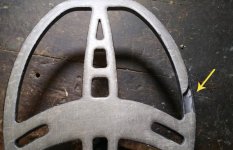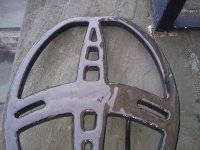Well, theres a couple tests you might be able to do. One is to ohm out the coil and verify resistance is in spec on each coil. Should be able to find the specs and pinouts online.
The other, and more accurate would be to check the coil's inductance. But that takes a special meter, and you would have to know the coil wire diameter and total length, or get the inductance spec somewhere. Problem being, the meter likely costs far more than a new coil. I learned that a long time ago when I had to buy one when I wound my own Tesla coils.
Finally, if you do attempt a repair, I would suggest a close examination for any other cracking or evidence of the windings being exposed. Make sure everything is as clean as possible, maybe using something like a good contact cleaner. Make a form ahead of time to pour your epoxy into the breach so that it doesnt run out. You will need a thin runny epoxy that will flow between the windings and seep into every possible gap. Use a long working time epoxy which will allow any bubbles to rise to the top.
Just make sure that whatever epoxy you use, it has a high dielectric rating, good hardness, and temperature range once hardened.
Next, bake the coil in the oven on the lowest setting so you dont melt the plastic. Make sure it's on a flat clean surface like an old cookie sheet to prevent warping. This should dry out any moisture. At this point, just do your repair with extra material on top which will likely be full of little bubbles. Sand/grind it down, and finish as you like.
Yeah, its lots of work and no guarantee it will work, but it could get you back up without a new coil. Good luck, and keep us posted!
Sent from my SM-N950U using Tapatalk

